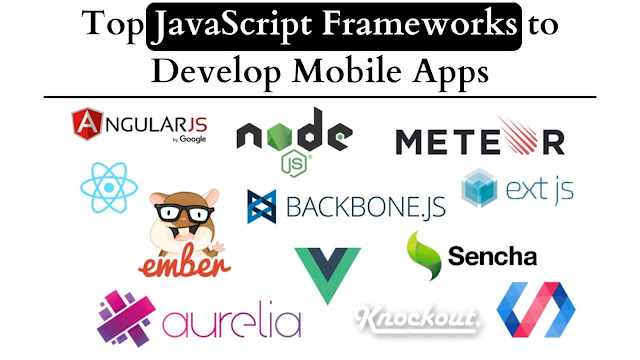JavaScript is one of the most famous programming languages among developers. More than 69% of developers use JavaScript instead of any other programming languages for developing web and mobile applications as it is capable of creating an interactive experience for the user.
For the development of mobile applications, we mainly use JavaScript frameworks as we can use them across various platforms such as Android, iOS, and windows. A developer can choose any JavaScript frameworks like, React Native, Xamarin, etc. as per the requirement and demand of the mobile application to be developed. In this article, we have discussed JavaScript and the top-most JavaScript frameworks that a developer can use to develop mobile applications.
Table of Contents
What is JavaScript?
Advantages of JavaScript.
What are JavaScript frameworks?
What is the difference between JavaScript frameworks and JavaScript libraries?
8 popular JavaScript frameworks.
Conclusion.
What is JavaScript?
JavaScript abbreviated as JS is an object-oriented and dynamic programming language used to design interactive web pages. It is also known as a text-based scripting language that helps us to validate, manipulate, and calculate the data.
JavaScript was first known as LiveScript and appeared for the first time in Netscape 2.0 web browser in the year 1995. JavaScript is lightweight and can be used on both the server-side and client-side. JS allows mobile app developers to access interactive elements which engage more users. With the help of JS, you can dynamically update content, animate images, control multimedia, and make web-based applications.
Advantages of JavaScript
Less Server Interaction - You can make the changes in the input before pushing the page off to the server, hence putting less load on the server.
Increased Interactivity - JavaScript allows you to create interfaces that easily react even when the user only touches the keys on the keyboard or hovers over them with a mouse.
Richer Interfaces - JavaScript includes various interactive features that offer a rich interface to your users. For example, sliders, drag-and-drop components, and more.
Immediate Feedback to the Users - One of the best advantages of JavaScript is that if a user has forgotten to enter something, he does not have to wait for the reloading of the page.
Frameworks are software that have been developed to fulfil the basic requirements and utilization needs of the developers in order to build applications. Javascript frameworks are the most used framework platform by developers to build various web-based and mobile applications. The following topic will help you to understand JavaScript frameworks better.
What are JavaScript frameworks?
JavaScript frameworks are defined as the collections of JavaScript code libraries, which include pre-written JavaScript codes that are used by software developers in order to perform regular programming tasks and features for developing web or mobile applications in JavaScript.
If you are keen to design and build an effective and interactive mobile app of your own, JavaScript frameworks would be the ideal platform for you. JavaScript frameworks are more efficient, less costly, and involve lower learning curves. There are several JavaScript frameworks available across the globe and every framework has its own specifications, features, and characteristics. It is very important to consider or analyze every JS framework and then choose the best one that suits the requirements of your mobile app.
What is the difference between JavaScript frameworks and JavaScript libraries?
What are the top most popular JavaScript frameworks?
Top 8 JavaScript Frameworks
React Native
React Native is one of the best and most popular open-source JavaScript frameworks for developing mobile applications. It was created by Facebook.Inc. Most of the developers choose React Native framework for mobile app development because of its optimum speed, competence, user interface, and less development cost. React Native is the most widely used technology in Native app development.
React Native framework allows you to develop mobile applications for multiple platforms like iOS, Android, Android TV, and more by offering the developers to write native codes in languages apart from JavaScript like Objective-C or Swift for iOS apps and Java or Kotlin for Android apps, Python for server end programming. React Native framework offers you an interactive experience and runs on a concept; “Learn once, write anywhere”.
Key Features of React Native JS Framework:
Big library of React components allows faster mobile app development.
Integration of components in programming languages like Java, Objective-C or Swift.
The third-party plugin support is consistent.
React Native supports Android and iOS with a single code base across several platforms.
React Native allows the user to operate the app smoothly because of the responsive interface.
Xamarin
Xamarin is a popular and open-source mobile app development framework from Microsoft in order to build efficient and modern Android and iOS apps using .NET and C# programming languages. It is a Cross-Platform framework and creates high-performance and native mobile apps. According to a survey conducted in the year 2017, more than 1.2 million developers across the globe use functionalities created through Xamarin. It has the capability to integrate with the latest components, native APIs, and backend services seamlessly. Xamarin is also responsible for expanding the .NET platform in order to develop and design mobile applications for Android, Windows, macOS, and iOS.
Key Features of Xamarin Framework.
Xamarin is for native performance.
It involves competent library support that allows you to access native APIs and 2D graphics from shared code.
It has the ability to create a standardized Cross-Platform user interface with Xamarin.Forms.
The Xamarin framework involves dedicated community support from various organizations and contributors.
It has great analytical tools and a flexible backend infrastructure.
Ionic
Ionic is another popular open-source JavaScript-based mobile app framework. It allows you to access a complete application development kit and operates on a single codebase. One of the main advantages of the Ionic framework is that you can build applications continually and port them to other platforms. The ionic framework helps you to create high-quality mobile apps for multiple platforms using a Cross-Platform app development kit.
Key Features of Ionic Framework.
The ionic framework includes various reusable UI components for most types of mobile devices.
It has the ability to build intuitive and high-quality applications for mobile devices.
It also includes a big library of front-end building blocks.
Involves framework compatibility and enhances stability.
NativeScript
NativeScript is an open-source, free, and Cross-Platform framework that is based on JavaScript and develops interactive mobile applications for both the Android and iOS platforms. NativeScript framework reduces the lines of code, and time to complete the development process of the mobile applications. You can build NativeScript apps using JavaScript or TypeScript programming languages. Most of the organizations across the globe are implementing NativeScript for the development of their apps because of various amazing features provided by the NativeScript framework.
Salient Features of NativeScript Framework.
It makes all the Android and iOS APIs available for the developer.
NativeScript framework allows you to access templates, plugins, and app samples for free.
It is very simple to learn and includes skill sets used in CSS, JavaScript, and Native UI markup.
It also involves great community and business support.
The Architecture of NativeScript Framework
AngularJS
AngularJS is a JavaScript-based, open-source framework, which is mainly maintained by Tech Giant Google. It is a structural framework used for the development of web and mobile-based applications. AngularJS is distributed as a JavaScript file and you can add it to an HTML page by using the <script> tag. AngularJS is one of the best JavaScript frameworks to assist in the testing and development of apps with MVVM and MVC architectures. Most of the developers prefer the AngularJS framework for mobile app development because it allows them to access plug-n-play components, and it also offers a native-like experience even for hybrid mobile applications. Here are some of the key elements of the AngularJS mobile development framework.
Key Features of AngularJS Framework.
AngularJS framework involves simple and agile code elements.
It also features two-way data binding.
A developer gets to experience personalized widget development in the AngularJS framework environment.
You can also add reusable code with their directives.
It features effective and excellent components such as sidebars, overlays, switches, etc.
PhoneGap/Cordova
PhoneGap is a popular mobile app development framework, which is a distribution of Apache Cordova. It is an open-source and flexible framework that allows you to reuse the same codes that you have written in CSS, HTML, and JavaScript in order to generate Application Programming Interfaces (APIs) for mobile operating systems like iOS and Android. Due to its ability to utilize the in-built JavaScript API to set up a connection with the Native functionalities of the operating system and mobile devices, the popularity of the PhoneGap framework is rising quickly. PhoneGap also includes a robust and large backend that helps you to develop native mobile applications easily.
Salient Features of PhoneGap/Cordova Framework.
It allows you to access the hardware of the devices.
App development is quite easy and simple.
It includes various useful libraries.
It features great platform compatibility.
jQuery Mobile
jQuery is one of the leading UI frameworks, which is based on JavaScript programming and has been created on the jQuery core. It is a lightweight framework and includes a simple API that allows you to develop a responsive and high-quality mobile application. It helps you to build single intuitive mobile applications that can work on various platforms and mobile devices seamlessly.
Salient Features of jQuery Mobile
The UI system of the jQuery framework is based on HTML.
It allows the user a Native-like experience.
It also includes a theme-oriented and flexible design.
jQuery Mobile is also compatible with other mobile frameworks.
Meteor
Meteor is one of the JavaScript-based frameworks that allows you to develop scalable, simple, and efficient mobile applications. It also allows you to integrate the latest technologies. In the Through /By the help of Meteor framework, you can build applications for any device using a single code base. Meteor framework involves less coding because it uses an integrated and extended JavaScript stack.
Key Features of Meteor Framework
It involves an easy integration with other front-end app development frameworks.
The prototyping is rapid in the Meteor framework.
It allows you to access the Meteor partners for training and development of the applications.
With Meteor framework, you can use the same code in front-end and back-end mobile app development.
Conclusion
The above article is about giving you brief knowledge that will help you while choosing a perfect JavaScript framework for mobile app development. You should always focus on the functionalities of the framework that are required for developing your mobile app instead of focusing on the number of features a particular framework includes. Hence, you can choose any of the above-mentioned JavaScript Frameworks according to the needs of your project that saves you time and cost/ money/ cost and time-effective.






0 Comments